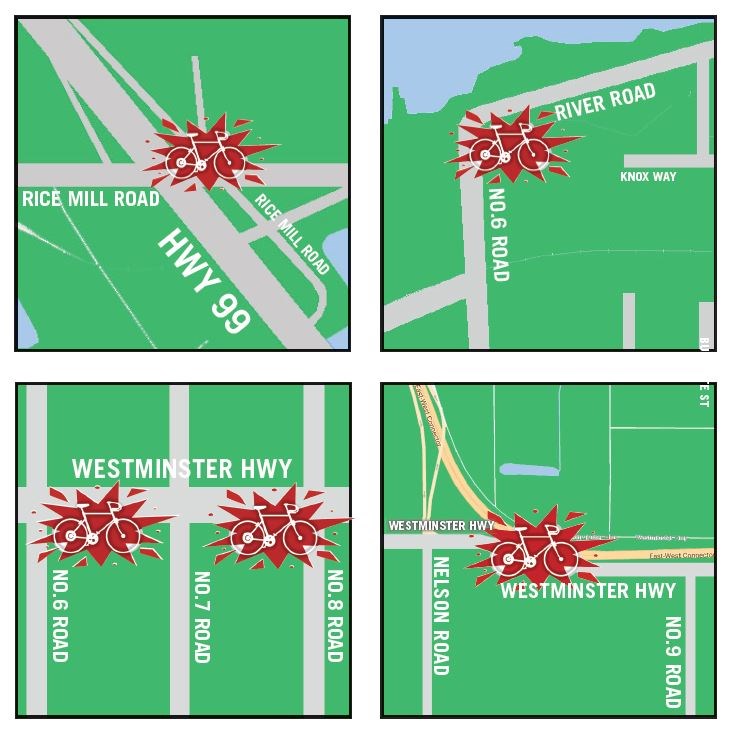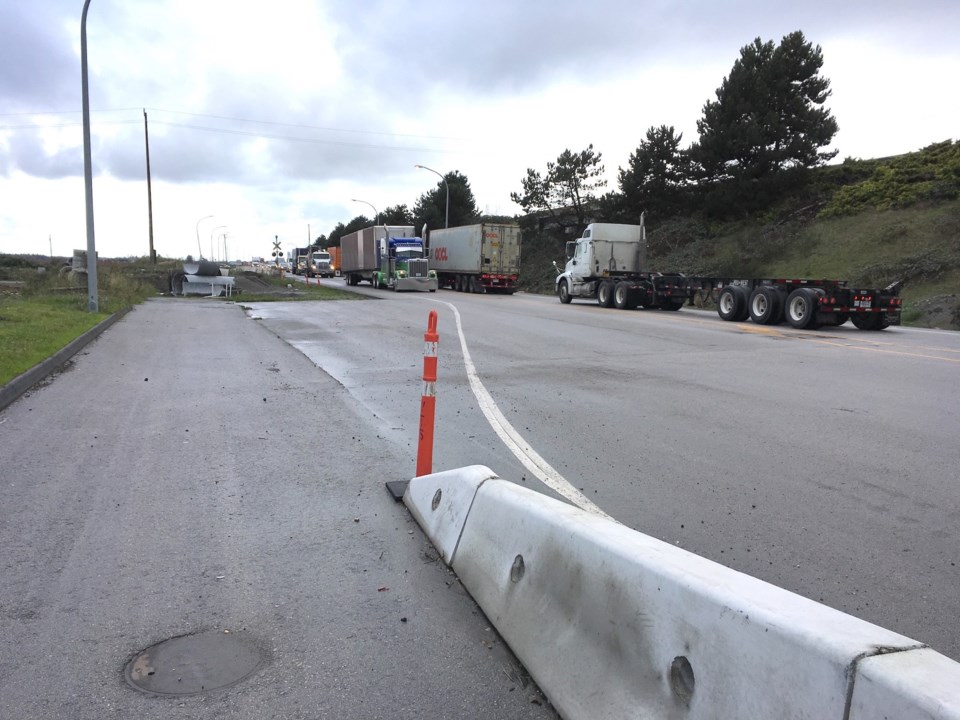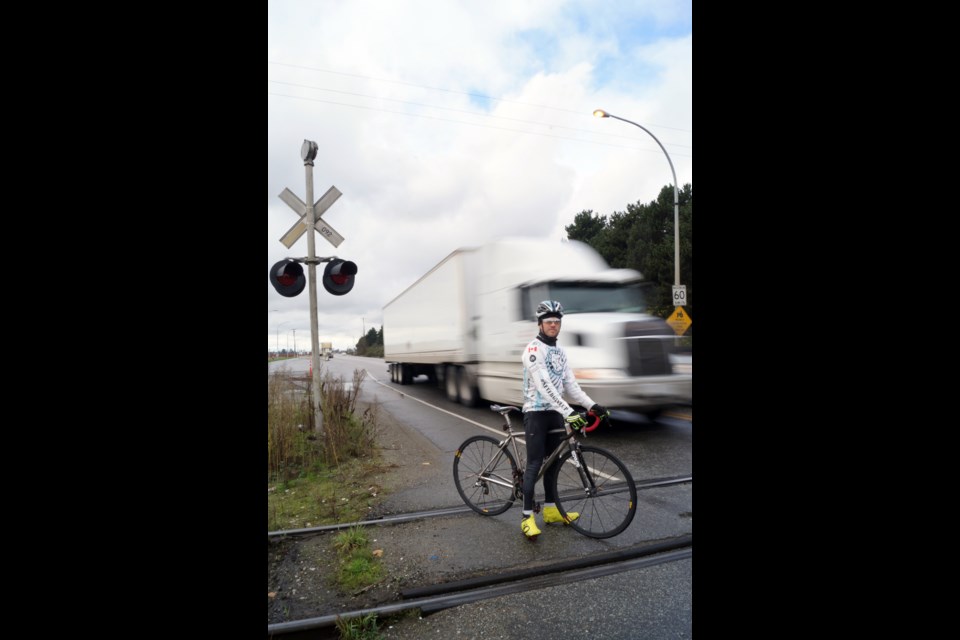To Mayor Malcolm Brodie,
I’m saddened that I did not send this letter before the death of cyclist Brad Dean, who was killed (Nov. 6) on River Road in Richmond.
I’ve been a clubmate of Brad’s for some years now, having cycled with him on many rides and shared transportation to out of town rides.
Let me introduce myself, and why I ask that you take what I say seriously.
I’m Geordie McGillivray. I was born in Richmond, and have lived in Richmond for 44 years. I ride my bike more than 20,000 kms per year. I would say that about 10,000 to 12,000 of those kilometres are in Richmond; I ride almost every day, rain or shine.
I am a cyclist — not a person who rides a bike. Let me explain the difference.
I am an experienced cyclist; I have competed in events; I am a ride leader for Just Giver cycling group (which Brad was part of); I volunteer to coach elementary school children bike safety and skills, and every year I renew my cycling insurance through Cycling BC. I ride on the road, with traffic if need be, but otherwise on the roadside bike lanes. My average speed is 30 km/h but I can keep up with traffic if needed. I’m serious about cycling, and coming home alive after every ride.
A person who rides a bike, many times, will have their helmets strapped to their backpack, or handlebars; They will ride on the sidewalks; They will ride on gravel paths while texting. They will do more to give cyclists a bad name in the eyes of pedestrians and vehicle drivers than anyone. That is not who this letter is about.
Over the years, I’ve identified every road, every intersection, and every section of road in Richmond where a cyclist could, or will be injured or killed.
What I am proposing is that I be brought in as an advisor, if you will, to help with the decisions and changes that are so sorely need in Richmond to prevent more carnage. Along with identifying all of the hot spots, I have solutions that would work. Simply, my solutions will save lives.
Coun. Ken Johnston, who thinks shutting down roads to cyclists (may be) the answer, is obviously a man who is not a cyclist and has no idea of the popularity of River Road with cyclists from all over the Lower Mainland.
That stretch of road, from No. 6 Road up to what is the equivalent of No. 10 Road, is the third most popular road for cyclists in all of Richmond. It is also one of only two roads where cyclists feel a sense of freedom since there are no traffic lights to interrupt the ride.
This road along with Dyke Road in south Richmond are the two main draws. The Railway Avenue corridor is also in the top three.
Let me quickly list a few of the areas in Richmond where I expect another cyclist will be injured or killed within the next two years.
River Road was on the list, and this has already happened, so we are now left with four locations.
I ask that you use my knowledge to make Richmond safer and bike routes designed by someone who actually rides a bike in this city instead of a designer sitting behind a desk who doesn’t know how cyclists actually flow with and without traffic around them. I have solutions for each of these listed below and would love to help.

1. Westminster Highway, between No. 9 and Nelson roads.
This disaster area started over 18 months ago and is still a death waiting to happen.
There was a bike lane “shoulder” on both sides of the road which worked perfectly well.
Then they were removed and a multi-use path was created on the south side of the road.
However, it stops before it gets to the railway tracks between Nelson and No. 9 roads.
So, now cyclists and pedestrians must merge with all of the 18-wheelers, which now have their nice two-lane roads coming from each direction, and squeeze over the tracks.
Plus, construction parts are still lying around, and the multi-use path is useless as it can’t be swept and is full of glass and debris most of the time.

2. Westminster Highway between No. 6 and No. 8 roads
A few years ago, someone said, “let’s make a multi-use path along this two miles stretch of road — it will be great!” And it is, if you want to get injured while riding your bike.
The path is on the south side of the road. What else is also on that side? A ton of driveways for farms, houses and businesses. What’s the issue? Every driveway has a thick hedge that goes right to the multi-use path, which a vehicle must then cross to get onto the road. Simple physics here. The average driver of a car sits about nine feet back from the front of the vehicle. The multi-use path is about eight feet wide. If a car comes out of it’s driveway, the only way the driver can see of there is a cyclist or pedestrian coming is by driving out all the way so the nose of the vehicle is touching Westminster Highway. Whoever thought this would work, obviously never rode a bike along this route.
As well, most days through the spring and summer there is a farm vehicle, utility vehicle or police car either parked, or driving on this multi-use path. Solution: this two-mile stretch happens to contains some of the widest, single vehicle lanes in all of Richmond. There is more than enough room for proper cycling lanes on each side of the road — just like on Railway.
3. River Road between No. 6 Road and its end ( de facto No. 10 Road)
A. The fact there is no controlled traffic lights at this intersection is a crime, given the amount of traffic using this road as a shortcut to Highway 91 and Westminster Highway. I’ve seen line-ups of cars half a mile long as drivers try to turn onto Westminster.
B. River Road, for all its traffic, including dump trucks, is one of the safest roads to ride on in Richmond. Why? The majority of traffic on it is familiar with the road and expect cyclists. Have you ever ridden a bike on Marine Drive in North Vancouver to Horseshoe Bay? It is twisty, there are no bike lanes, and when traffic builds up behind bikes, drivers understand and they wait. Even all of the buses on that road know it’s a cycling route. Technically, it’s the most dangerous “popular” road in North Vancouver for cyclists, and yet it’s the most used. You don’t see North Vancouver councillors saying they need to shut it down.
Solution: There is an extra gravel shoulder on both sides that could be used to widen the road for a bike shoulder. Also, the 30/kmh speed limit that is already in effect for part of River Road should be extended.
Since Brad’s death, cars are giving me a very wide berth, which is nice, but they are crossing into the other lane of oncoming traffic, and it’s getting dangerous for everyone.
4. Highway 99 between Rice Mill Road and Steveston Highway
This small section of road, where the old Richmond Information Centre used to be, is one of the most used sections of road for cyclist in all of Richmond — travelling in both directions. It’s the only way to directly connect from the bike shuttle service to Sidaway Road, which is the designated safe route. It is vital to completing a complete lap of Lulu Island and is used for all charity bike rides.
Solution: Installing reflective pylons around the shoulder corner leading from the information centre area to the bus stop at Steveston Highway to deter vehicles from cutting that corner. If a vehicle “needs” to pull off to the shoulder, it still can as the pylons bend.
I’m aware of at least 10 more sections of road in Richmond similar to the above. I have solutions to all of those, as well. I have short term, and long term solutions, both economical and expensive. I’m not sure how much Richmond City Hall thinks Brad’s life is worth, or the life of any of us cyclists, but I’d like to find out. Richmond is flat and has hardly any blind corners — the fixes are easy compared to other cities.
Most people who drive vehicles would never know about these issues (and I drive a car, too.) They are oblivious to the situation that doesn’t apply to their big metal box. I’m a single father of an 11-year-old girl, and getting home every day safely is my priority.
I want to make something very clear: If Ken Johnston wants to shut down River Road, cyclists will have to be rerouted onto Westminster Highway. This will inevitably lead to more injury and death.
I’ve been thinking about this for a year, and now a friend has been killed. I regret I have sat on this for so long. Perhaps no road improvements would have prevented this tragedy, but I can’t sit back now.
Geordie McGillivray
Richmond
Bike upgrades made along side larger projects: City
A spokesperson for the City of Richmond says improving the municipality’s cycling networks is a matter of priorities and funding.
“We are working to incrementally add to our cycling network,” said Ted Townsend.
“It’s a question of priorities. If we were prepared to throw more money at it, then sure, we could do more. But we have to balance it with many other priorities,” said Townsend.
As it stands Townsend said the city is investing in improvements to cycling lanes, particularly when senior governments assist in funding.
For example, last year the federal government granted the city $3.5 million to widen No. 2 Road from Steveston Highway to Dyke Road, as part of improving access to Steveston Harbour (Asia-Pacific Gateway funding). The $7.3 million project will be topped up with municipal funds. It will see utility poles moved to accommodate a bike path on the east side of the road from the highway to just beyond Andrews Road. The bike lane will shift to the west until Dyke.
Many cycling network upgrades also occur when there is redevelopment. For instance, when a new street is built, cycling lanes are added, such as in the Oval Village.
A common criticism of Richmond’s cycling network is the gaps that exist.
“Obviously there are gaps that exist. We want to address the gaps, but there’s a whole wide variety of criteria that come into play with what projects get built,” Townsend said.
He explained, for example, the Westminster bike path was built when the federal government provided funding for the Nelson Road interchange (for port truck traffic).
That path is incomplete because the city is waiting on CN Rail to upgrade its crossing.
There are also smaller, incremental upgrades, said Townsend.
“We also make significant investments annually in other traffic safety improvements such as traffic calming measures, new traffic signals and intersection improvements.”
Last year the city invested $300,000 directly in such improvements.
-Graeme Wood/Richmond News



